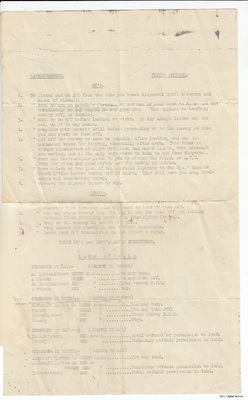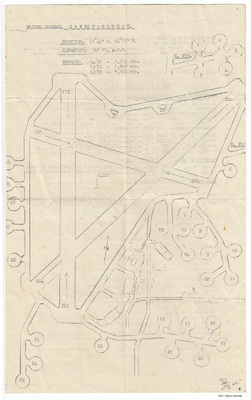Flying control - Haverfordwest
Title
Flying control - Haverfordwest
Description
List of do's and don'ts for flying operations at Haverfordwest as well as a list of lamp signals and a map of the airfield with runways and dispersals marked.
Coverage
Language
Format
Two page printed document
Publisher
Rights
This content is available under a CC BY-NC 4.0 International license (Creative Commons Attribution-NonCommercial 4.0). It has been published ‘as is’ and may contain inaccuracies or culturally inappropriate references that do not necessarily reflect the official policy or position of the University of Lincoln or the International Bomber Command Centre. For more information, visit https://creativecommons.org/licenses/by-nc/4.0/ and https://ibccdigitalarchive.lincoln.ac.uk/omeka/legal.
Contributor
Identifier
MGoodwinWJ419914-170607-02
Transcription
[underlined]HAVERFORDWEST FLYING CONTROL[/underlined]
[underlined]DO’s[/underlined]
1. DO listen out on R/T from the time you leave dispersal until airborne and clear of circuit.
2. DO keep an eye on A.F.C.’s Caravan, or get one of your crew to do so and act immediately on any signal he may give you. This applies to taxying; taking off or landing.
3. DO call up on R/T before landing at night. By day always listen out and call up if in any doubt.
4. DO complete your cockpit drill before proceeding on to the runway so that you are ready to take off.
5. DO get off the runway as soon as possible after landing, and use the perimeter track for taxying, especially after dark. This track is always illuminated at night with blue and amber lights, when aircraft are moving, and is the only safe route to take to and from dispersal.
6. DO obey all instructions given to you by either F.C.O. or A.F.C. They are given for your safety and the safety of others.
7. DO have a look at the plan of the airfield lighting in the Ops Room or Watch Office before taking off at night. This will save you many headaches and unnecessary worry.
8. DO observe the Signals Square by day.
[underlined]DON’TS[/underlined]
1. DON’T waist time on the runway after landing but taxy off without delay.
2. DON’T use any other runway than the one in use for take off and landing without first obtaining permission from Flying Control.
3. DON’T taxy on the runway in use at any time.
4. DON’T taxy across the runway in use without permission.
5. DON’T leave your R/T transmitter on and expect a reply.
THESE DO’S AND DON’TS APPLY EVERYWHERE.
[underlined]LAMP SIGNALS[/underlined]
REMEMBER BY DAY: - (GROUND TO GROUND)
An intermittent GREEN – means you may taxy.
A steady GREEN – means you may take off.
An intermittent RED – means clear runway P.D.Q.
A steady RED – means stop.
REMEMBER BY NIGHT: - (ground to ground)
Aircraft letter in GREEN means you may taxy.
Steady GREEN means you may take off.
Intermittent RED means clear runway P.D.Q.
Steady RED means stop.
REMEMBER BY DAY: - (ground to air)
Intermittent RED means total refusal of permission to land.
Steady RED means temporary refusal permission to land.
REMEMBER BY NIGHT: - (ground to air)
Aircraft letter in GREEN means you may land.
Aircraft letter in RED or steady RED means temporary refusal permission to land.
Intermittent RED means Total refusal permission to land.
[page break]
[map of Haverfordwest Airfield]
[underlined]DO’s[/underlined]
1. DO listen out on R/T from the time you leave dispersal until airborne and clear of circuit.
2. DO keep an eye on A.F.C.’s Caravan, or get one of your crew to do so and act immediately on any signal he may give you. This applies to taxying; taking off or landing.
3. DO call up on R/T before landing at night. By day always listen out and call up if in any doubt.
4. DO complete your cockpit drill before proceeding on to the runway so that you are ready to take off.
5. DO get off the runway as soon as possible after landing, and use the perimeter track for taxying, especially after dark. This track is always illuminated at night with blue and amber lights, when aircraft are moving, and is the only safe route to take to and from dispersal.
6. DO obey all instructions given to you by either F.C.O. or A.F.C. They are given for your safety and the safety of others.
7. DO have a look at the plan of the airfield lighting in the Ops Room or Watch Office before taking off at night. This will save you many headaches and unnecessary worry.
8. DO observe the Signals Square by day.
[underlined]DON’TS[/underlined]
1. DON’T waist time on the runway after landing but taxy off without delay.
2. DON’T use any other runway than the one in use for take off and landing without first obtaining permission from Flying Control.
3. DON’T taxy on the runway in use at any time.
4. DON’T taxy across the runway in use without permission.
5. DON’T leave your R/T transmitter on and expect a reply.
THESE DO’S AND DON’TS APPLY EVERYWHERE.
[underlined]LAMP SIGNALS[/underlined]
REMEMBER BY DAY: - (GROUND TO GROUND)
An intermittent GREEN – means you may taxy.
A steady GREEN – means you may take off.
An intermittent RED – means clear runway P.D.Q.
A steady RED – means stop.
REMEMBER BY NIGHT: - (ground to ground)
Aircraft letter in GREEN means you may taxy.
Steady GREEN means you may take off.
Intermittent RED means clear runway P.D.Q.
Steady RED means stop.
REMEMBER BY DAY: - (ground to air)
Intermittent RED means total refusal of permission to land.
Steady RED means temporary refusal permission to land.
REMEMBER BY NIGHT: - (ground to air)
Aircraft letter in GREEN means you may land.
Aircraft letter in RED or steady RED means temporary refusal permission to land.
Intermittent RED means Total refusal permission to land.
[page break]
[map of Haverfordwest Airfield]
Collection
Citation
“Flying control - Haverfordwest,” IBCC Digital Archive, accessed July 26, 2024, https://ibccdigitalarchive.lincoln.ac.uk/omeka/collections/document/31078.
Item Relations
This item has no relations.


